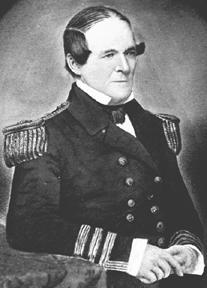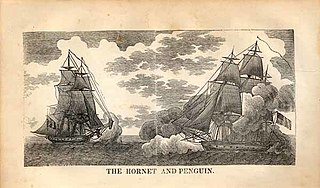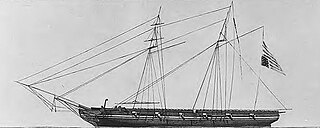
Eight ships of the United States Navy have been named USS Hornet, after the stinging insect:

The third USS Hornet was a brig-rigged sloop-of-war in the United States Navy. During the War of 1812, she was the first U.S. Navy ship to capture a British privateer.

Cornelius Kinchiloe Stribling was a rear admiral in the United States Navy who served during the War of 1812, the Second Barbary War, the Mexican–American War, and the American Civil War.

Lewis Warrington was an officer in the United States Navy during the Barbary Wars and the War of 1812. He later became a Captain. He temporarily served as the Secretary of the Navy. His highest rank was commodore.

HMS Fury was a Hecla-class bomb vessel of the British Royal Navy.

On 23 March 1815 USS Hornet captured HMS Penguin in a short battle off Tristan da Cunha. It was one of several engagements that took place after the War of 1812 had ended, and was the final action between British and American forces. The American gunnery was far more effective than the British, despite the two vessels being virtually identical in strength. After exchanges of broadsides and musket fire, the British commander was killed. The British brig rammed the American ship in an attempt to board, but the two were separated and Penguin was disabled shortly afterwards when the foremast fell, forcing the British to surrender. The British brig was too badly damaged to be salvaged and was set ablaze by the victors after its stores and surviving crew were removed.

HMS Cornwallis was a 74-gun third rate ship of the line of the Royal Navy, launched on 12 May 1813 at Bombay. She was built of teak. The capture of Java by USS Constitution delayed the completion of Cornwallis as Java had been bringing her copper sheathing from England.

The Téméraire-class ships of the line were a class of a hundred and twenty 74-gun ships of the line ordered between 1782 and 1813 for the French navy or its attached navies in dependent (French-occupied) territories. Although a few of these were cancelled, the type was and remains the most numerous class of capital ship ever built to a single design.

HMS Belette was an 18-gun Cruizer-class brig-sloop, built by Edward Larking and William Spong at Kings Lynn and launched in 1814. She was the second Cruizer-class brig-sloop to bear the name. Belette had an uneventful career performing peacetime patrols and was sold in 1828.

HMS Penguin was a Royal Navy Cruizer-class brig-sloop launched in 1813. In 1815 USS Hornet captured Penguin in a battle that took place after the end of the War of 1812. Hornet then scuttled Penguin as she was too damaged to merit keeping.
Edward Trenchard (1785–1824) was a captain of the United States Navy, who saw service in the Quasi-War with France, the First Barbary War, the War of 1812, and the Second Barbary War. He was the father of Rear Admiral Stephen Decatur Trenchard.

The West Indies Anti-Piracy Operations refer to the United States Navy presence in the Antilles, and surrounding waters, which fought against pirates. Between 1814 and 1825, the American West Indies Squadron constantly pursued pirates on sea and land, primarily around Cuba and Puerto Rico.After the capture of Roberto Cofresi in 1825, acts of piracy became rare, and the operation was considered a success, although limited occurrences went on until slightly after the start of the 20th century.

HMS Peacock was a Cruizer-class brig-sloop of the Royal Navy. She was launched in 1806 and had a relatively uneventful career until she had the misfortune to encounter USS Hornet in February 1813. Hornet captured Peacock, which then sank.
Jamaica Dockyard also known as Port Royal Dockyard was a British Royal Navy Dockyard located at Port Royal, Jamaica. It was established 1675 and closed in 1905. The dockyard was initially administered by the Navy Board then later the Board of Admiralty.
Lord Wellington was launched in 1811 in Montreal. She became a London-based transport that made one voyage to India in 1819 under a license from the British East India Company (EIC). Afterwards she continued to sail to the Baltic and North America. She was last listed in 1829.










